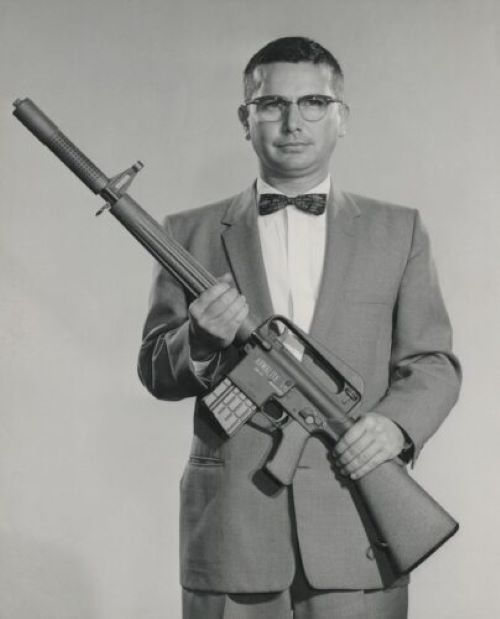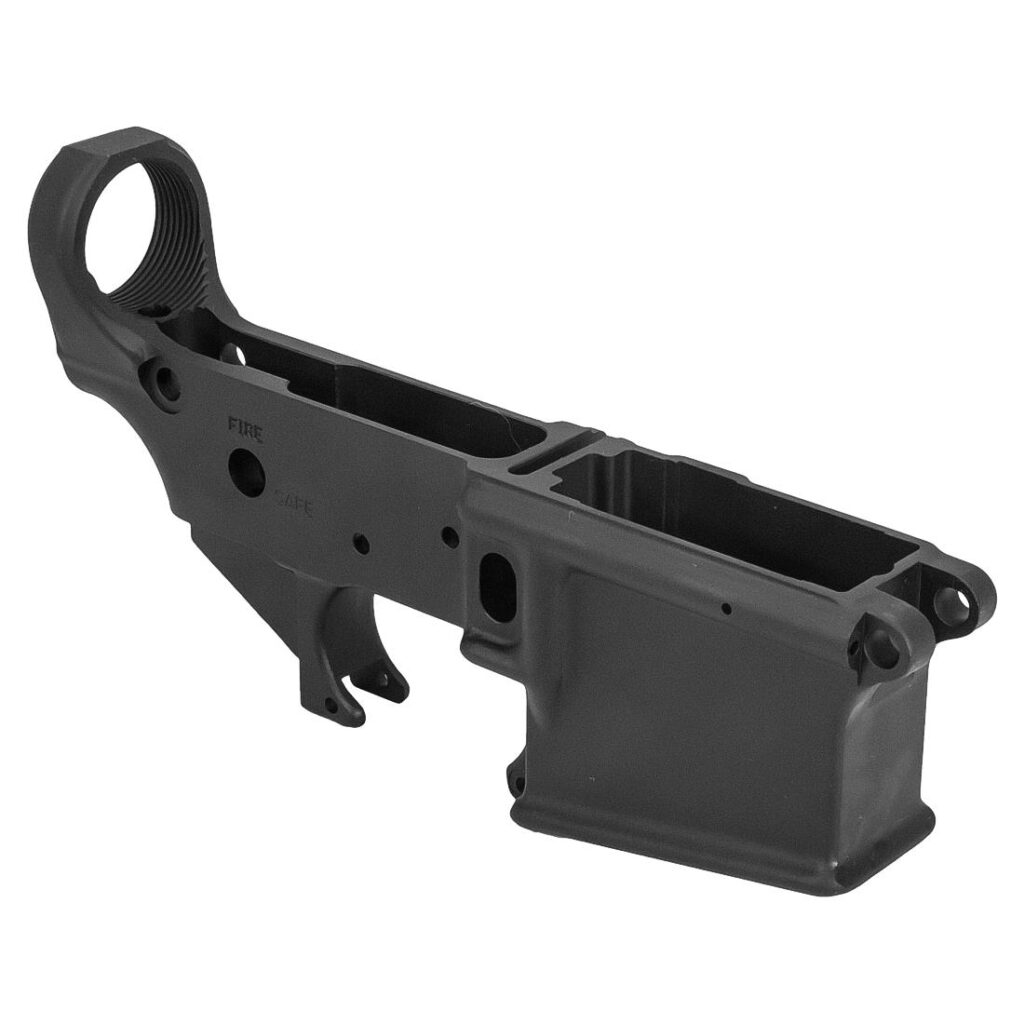The video co-produced with Cody Cresmen
The AR-15 is a popular semiautomatic rifle that has seen extreme controversy for its use in mass shootings. We spoke with the owner of Tagged Out Hunting Supply in Sylva, Dustin Hayes who opened store three years ago.
Hear his opinion on the rifle and learn about its popularity.
Footage by Brandon Dover and Cody Cresmen.
The AR-15 may currently be staple of the firearms market, but it started as almost the complete opposite.
The Beginning
The rifle, developed by Eugene Stoner, started development at Armalite as a version of the AR-10 rifle designed to fire .223 Remington cartridges. Due to Armalite’s financial struggles, they sold the rifle to Colt firearms in 1959 for $325,000, which equates to $3.2 million today.

In 1960, Robert MacDonald, an executive from Cooper-MacDonald which brokered the deal and gained royalties from sales, introduced the gun to Air Force Vice Chief of Staff, Curtis Lemay, who was impressed and ordered 8,500 for Air Force security guards. Lemay’s requests were initially denied by the US Army Ordnance Corps, but after repeated requests, the rifle was approved. Secretary of Defense at the time, Robert MacNamara learned about the gun due to the conflict between Lemay and the Army and ordered that a small batch of AR-15s be sent to Vietnam for use by the South Vietnamese military and American Special Forces.
Vietnam: Triumph and Trouble
The AR-15 performed well in its initial testing program, named project AGILE. These tests gave many the impression that the AR-15 was superior to the US Army standard rifle, the M14. The rifle was then adopted as a standard, earning the designation M16. The M16 would see its first wide-scale deployment in combat during the battle of La Drang, Vietnam, in 1965.

A few months after the M16 saw wide adoption, issues with the rifle started to become common. The issues primarily stemmed from two things: the powder in the ammunition, and the lack of chrome lining in the barrels of the M16.
The AR-15 was originally built around ammunition that used “stick” powder. The Army switched to “ball” powder because of its preference for “ball” powder, easier mass production, and its relationship with Olin Mathieson, which mass produced “ball” powder. This caused issues because the powder created more pressure in the gun than “stick” powder. This caused the gun to malfunction frequently.
The chrome lining of barrels was important because it prevented corrosion within the gun that also caused malfunctions. This issue surprised many people because the M1 Garand experienced the same issue in WWII which is where the chrome barrel solution came from.
The issues with the M16 led to the creation of a congressional committee in 1967 that interviewed officials within Colt and the Army to determine the source of the problem. The committee found that the Army had failed to test the M16 properly and even ignored tests which showed the malfunction issues before the malfunctions began in Vietnam.
The committee discovered that the Army disliked the rifle because it was NIH, or “not invented here.” This led to the Army mistreating the M16 so it could get rid of the rifle so it either return to the M14 or develop its own rifle to rival the Soviet AK47.
The final report by the committee, named the Ichord Report, would highlight the issues to the public as well as other government officials. Congressman Ichord himself would describe the Army’s behavior as “criminal negligence.”
Civilian Sales Pre-Ban
Due to the M16’s use and controversy in Vietnam, the gun initially sold poorly on the civilian market. Sales slightly increased after the patent on the AR-15’s gas system expired in 1977.This continued until the 1994 Assault Weapons Ban when the sale of semi-automatic rifles such as the AR-15 illegal. The ban expired in 2004. The Bush administration allowed the ban to expire, citing research that showed the ban had no significant effect on gun crime.
Civilian sales post-ban
Following the expiration of the ban, the AR-15 immediately became an extremely popular item. Every subsequent mention of gun control has caused sales of the gun to spike out of fear it might be taken off the market again.
The AR-15 is popular for several reasons. The first is the gun’s versatility. Since the part of the gun with the serial number is legally considered the gun, the AR-15’s lower receiver is considered to legally be a firearm in and of itself. The lower receiver of the AR-15 houses the trigger and the fire control group, which operates the weapon. This means that, by changing the upper receiver, the gun can be made to fire almost any caliber of cartridge. This ranges from large hunting calibers like 6.5 Creedmoor to .410 shotgun shells.

The second reason for the gun’s popularity is the use of high-capacity magazines. These magazines can allow the gun to fire 20 to 30 times before needing to reload. This makes the gun optimal for self -defense situations, as well as hunting animals that travel in packs. One example of this is the wild boar. Wild boars have large tusks and often kill farm animals. Boar also have thick hides meaning less powerful calibers won’t punch through and larger calibers often found in hunting rifles can’t be loaded in quantities that will accommodate the large packs boar travel in. This makes the AR-15 and its variants ideal for this situation.
Currently, the AR-15 is more popular than ever before, with approximately 1 in 20 Americans owning one. The gun has become a symbol for American gun culture as a whole. However, the gun has as much controversy surrounding it as it does love.
“The mass shooter’s weapon of choice” Statistics says no
The AR-15 has recently gained a reputation for being the most common weapon used in mass shootings. This originates from its use in some of the most infamous mass shootings such as Sandy Hook and Mandalay Bay. However, it is not the most common weapon used in mass shootings as a whole.
Research shows that the most common type of weapon used by mass shooters is a semiautomatic handgun. This is because handguns are easier to conceal and are often cheaper than rifles.
The future of the AR-15
While efforts to replace the AR-15 within the military have gained ground in recent years, it is likely that the AR-15 will remain the standard service rifle for the foreseeable future.
Another part of the AR-15’s future is 3D printing. Since the lower receiver does not feel any of the heat or pressure generated by the firing of rounds, the lower can easily be 3D printed. For legal sales, this means that receivers will be cheaper but still serialized. For illegal sales, this means that receivers for semi-automatic or even fully automatic AR-15s can be made outside the scope of the law and once criminals have the receivers, the other parts are easier to acquire.
Talks about regulation of the AR-15 have been constant since it began being used in mass shootings. While legislation has been passed, it has never stuck due to issues of effectiveness and 2nd Amendment rights. Any new legislation would be put to the test against a conservative Supreme Court that has previously ruled in favor of gun rights.
The fight over the AR-15 in the State of North Carolina is similar to the fight on the federal level. The State Congress of North Carolina has recently passed legislation allowing handguns to be purchased without a permit. It is poised to act in favor of gun rights in the future.
The AR-15 is only continuing to remain a staple of the civilian firearms market. While video games and social media have sparked controversies around the rifle, they have also made many people interested in firearms that would not have been interested previously. The internet has also helped people learn more about the rifle and its history. These factors have made AR-15s reach new heights in popularity, meaning that it is likely here to stay.



